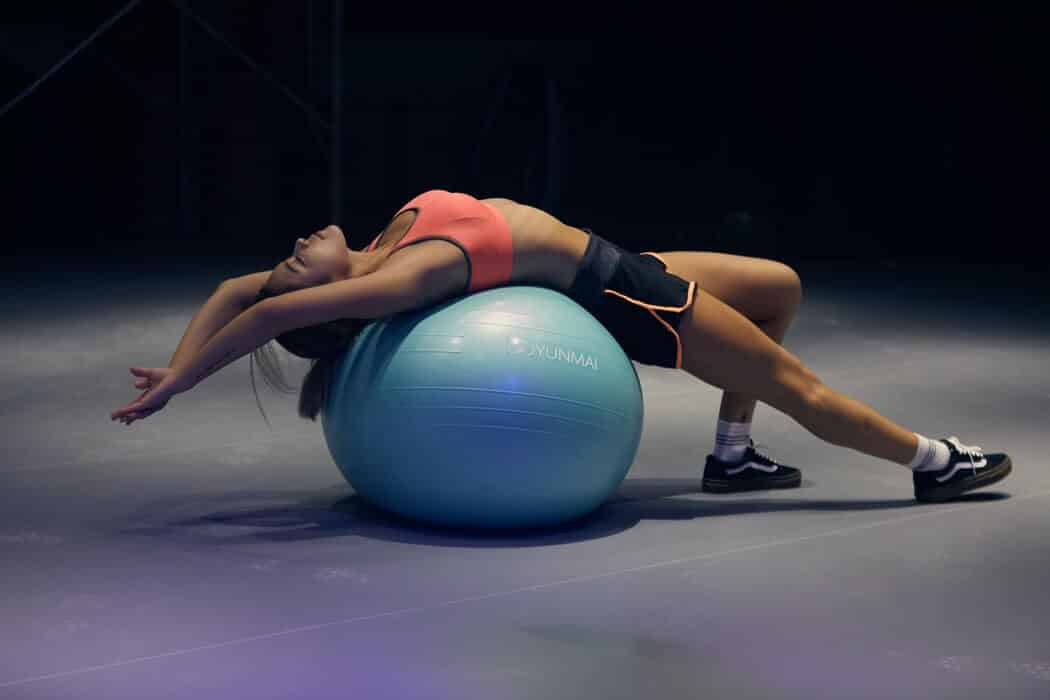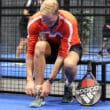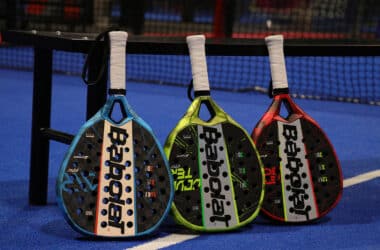Have you been injured while playing padel? Then you are most likely in the right place. In this article we’ll go through 6 common padel injuries, how you should think about rehab and how to prevent them in the future.
Use the quick navigation below to go to the section you want to learn more about.
Navigera direkt till din padelskada
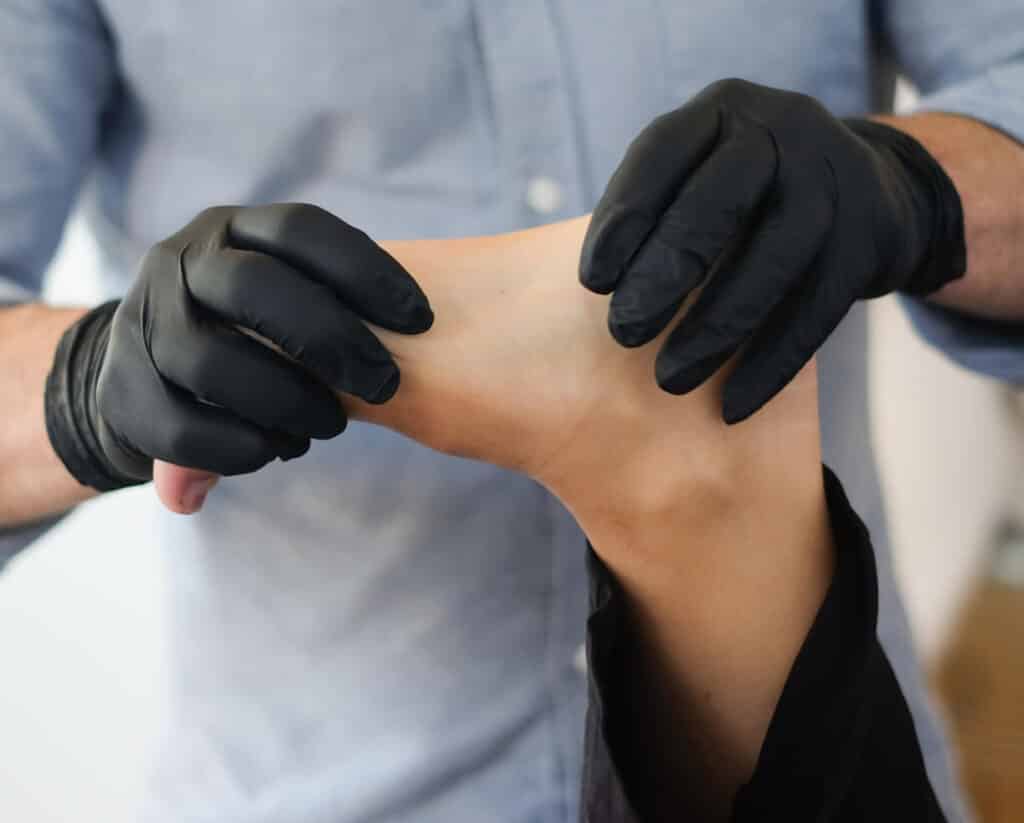
Padel injury to the tendons- also called ruptured heel tendons or heel tendon rupture.
Tendon injuries are relatively common in padel. A tendon can either partially rupture (partial rupture) or completely rupture (total rupture). The extent of the injury is always assessed during a medical examination and a possible X-ray or ultrasound of the heel tendon. Whether or not the heel tendon should then be operated on before rehabilitation can begin is always a decision taken by a doctor.
Cause of injury
Common causes of heel tendon rupture are often the rapid changes in direction that occur in padel, which wear on the heel tendon. A repetitive pattern of movement over a long period of time can also be the cause of a heel tendon rupture. With age, the heel tendon, like other tissues in the body, also becomes less elastic, which also increases the risk of injury. Today, most ruptured heel tendons occur in male athletes aged 35-55.
How to prevent
Prevention of heel tendon injuries, known as prehab, is always just as important. The heel tendon, which is the largest tendon in the body, has its upper muscle attachments on either side of the knee and lower muscle attachment on the heel bone under the foot, making it important to strengthen the entire calf musculature. Strength training for the calf muscles, hamstrings (back of thigh), and quadriceps (front of thigh) is always recommended.
Proper warm-up with associated gentle stretching of the heel tendon before starting to play should also always be a priority. Good padel shoes with good cushioning are also a really good investment that should definitely not be forgotten. A good pair of shoe inserts will also take the strain off the heel tendon and further prevent injury.
Wearing good shoes outside the padel court is also important to prevent heel injuries. Shoes with thin, flat soles without any cushioning or structure under the arch, such as Converse or flip-flops, are not recommended to be worn for long periods.
Asics Gel Challanger 13 Clay Padel
Rehab to get you back
Rehabilitation for heel injuries can look different depending on whether or not surgery has been performed. Good exercises regardless of whether surgery has taken place or not are;
Bending and stretching the ankle, 3 x 20 times, 3-4 times daily.
Toe lifts from a flat surface. Standing up and standing on tiptoe to freeze for a second in the upper position. 3 x 20 times, 3-4 times daily.
Eccentric toe raises. Stand on a step with the front of both feet on the step and the rest of the feet off the step. Gently lower the injured foot and stay there for a few seconds. Return to a neutral position with the healthy foot (the injured foot only lowers the foot), repeat the exercise. 3 x 20 times, 3-4 times a day.
Gentle stretching of the heel tendon against either a wall or on steps is recommended continuously. During visits to a physiotherapist, shock wave therapy has proved to be the most effective treatment for this type of injury.
Circulation-promoting massage of the calf muscles (not directly on the most prominent part of the heel tendon) and therapeutic stretching are also useful during both rehab and prehab. A slow return to activity is recommended and where even kinesiology taping of the heel tendon and calf can relieve the strain.
Pacific Ankle Support
Padel arm bow
Padel elbow, or as it is commonly called, Tennis Elbow (Lateral Epicondylitis), is one of the most common injuries in racket sports. The pain can be distinct and is always localized to the outer muscle joint of the elbow joint. In some cases, the pain may also radiate down the forearm and/or hand.
Cause of the injury
Paddle elbow is an overuse injury resulting from a repetitive movement pattern. The injury does not have to occur from prolonged overuse but can also occur after one or a few training sessions.
The overload that occurs creates inflammation in the outer muscle attachment of the elbow and can be painful, especially during fine motor movements such as hand shaking or grasping a coffee cup etc. Pain at night is also common, as it can be difficult to find a relieving and comfortable position for the elbow joint.
How to prevent padel elbow
Stretching of the forearm muscles, focusing on the extensor muscles (on the upper side of the forearm), is recommended at least 3-4 times a day and for 4-5 minutes each time.
As the injury is an overuse injury, it is always a good idea not to repeat unaccustomed movements that can trigger an injury. There are several padel rackets that are said to help prevent it. Any repetitive movements where the wrist is either bent backward over and over again or static (such as typing on a keyboard, painting a house, and of course, racket sports) should be done sparingly.
Taping with kinesiology tape and epicondylitis bandages can also help prevent the injury.
Babolat Elbow Support
Rehab to get you back
In the case of paddle elbow, shockwave therapy has been shown to be most effective. Ultrasound treatment and acupuncture can also help during the healing process. Deep therapeutic massage of the forearm extensor muscles with associated therapeutic stretching is always recommended, as is continuous self-stretching.
As with all types of injuries, a slowly increasing and gradual return to activity is important. The injury will always heal on its own over time, but unfortunately can take a long time to heal, quite often 6-12 months.
Twisted and sprained foot in padel
Twisted and sprained foot is also a very common padel injury. One of the most common sports injuries in the world by far (regardless of the sport), it is painful and always occurs suddenly.
Causes of sprains and twists
A sprained or twisted foot is always caused by pedaling under load, causing the foot to bend inwards or outwards. Ankle sprains when the foot is bent inwards (called supination) are over 90% more common than ankle sprains when the foot is bent outwards. When an ankle sprains inwards, the pain occurs rapidly on the outside of the foot below the ball of the foot.
How to prevent a sprained foot
Balance plate training is by far one of the best prehab exercises that can be done to prevent damage to the ligaments of the foot. Ankle braces, taping, and bandaging the foot reduces the stress that occurs in the ankle joint. The important thing to remember when taping and bandaging are that the ligaments should be kept short and not lengthened when applied.
This means that if there is an injury to the outer ligaments of the foot, 1. Start taping or bandaging on the inside of the foot under the inner ball of the foot, and then pull the tape or bandage outwards under the foot; 2. Inwards over the foot; 3. Outwards under the foot, etc. Good footwear that keeps the foot stable inside the shoe during activity and in everyday life is also important.
Pacific Ankle Support
Rehab to get you back
Already on day 1 you can start with bending and stretching your toes, 3 x 20 times, 5 times a day.
From day 2-3, flex and stretch the ankle, 3 x 20 times, 5 times daily.
Day 3-4, toe raises (up on toe) from a flat surface, 3 x 20 times, 5 times daily.
From day 5-6, balance plate training can begin. Stand on the balance plate only with the injured foot on the balance plate and the other healthy foot in the air. This can initially be done 1-2 times a day for 5 minutes each time and then gradually increased.
Knee injuries in padel
Knee injuries are also relatively common in the sport of padel. Meniscus injuries, sprained ligaments, hamstring and bursitis are just a few examples of the different types of knee injuries that can occur in padel.
Causes of common knee injuries
Knee injuries can be much more complicated than many other types of sports injuries. On the one hand, injuries can occur as a result of sudden events (such as rapid changes of direction in padel), which can often result in ligament damage, but knee injuries can also occur as a result of prolonged systematic overuse, as in the case of jumping knees (so-called because the injury is common in athletics jumping but also in basketball and badminton).
What can also complicate the investigation of a knee injury is that so many different types of injuries can occur and that a lot of tissue in and around the knee has to fit into a small area and can be damaged.
How to prevent knee injuries
Strength training to strengthen up the muscles (Hamstrings and Quadriceps) but also the calf muscles around the knee joint should always be a priority for prevention.
A stabilizing knee brace, kinesiology tape, or bandage can also help stabilize the knee joint while also reducing strain.
Again, a pair of stable and cushioning padel shoes is a very good investment to prevent injury, just as it is when using good shoes in everyday life.
Rehab to get you back
Depending on the type of knee injury and what the Physiotherapist has prescribed, rehabilitation may look different, however, some good basic rehab exercises are:
- Straight leg lift. Lie on your back in bed or on the floor and slowly raise the injured leg about 40-50 cm from the surface, stay in the upper position for a second and then slowly bring the leg down and repeat the exercise. 3 x 20 times, 5 times a day.
- Leg curls with only your own body weight. Slowly sit down on a chair behind you and then stand up again. Repeat 3 x 20 times, 5 times a day.
- Strength training in the gym with weight-bearing can be started after consultation with a physiotherapist.
- Hamstrings, quadriceps, and calf stretching. 15-20 seconds x 5, 5 times a day.
In the early stages of the injury, light circulation-promoting massage treatment. The treatment then gradually progresses to a deeper therapeutic massage treatment followed by therapeutic stretching of the muscles.
Padel shoulder injuries
Shoulder joint injuries can often be complex injuries, both in padel sports and in other sports. The shoulder joint is one of two joints in the human body (together with the hip joint) that can perform all anatomical directions of movement, which together with the fact that a lot of tissue has to fit into a small area, can complicate the healing process.
Frozen Shoulder, Rotator Cuff Pain, Dislocation, Impingement Syndrome, Calcaneal Shoulder, and Muscle Breakdown are different types of shoulder injuries that can all occur in the sport of padel.
Causes of shoulder injuries
Shoulder injuries, like many other sports injuries, can occur acutely or after prolonged overuse. Common acute shoulder injuries are muscle rupture and dislocation of the shoulder joint, both of which require immediate emergency medical attention. Bursitis and rotator cuff pain are examples of shoulder injuries that, on the contrary, occur after prolonged systematic overloading of the shoulder joint.
How to prevent a shoulder injurie
Strength training and proper stretching of the surrounding muscles of the shoulder joint are always recommended. Regular mobility exercises for all anatomical directions of movement of the shoulder joint (flexion, extension, abduction, adduction, and inward and outward rotation) are also important to maintain the flexibility of the shoulder joint.
Deeper therapeutic massage treatment followed by therapeutic stretching also helps to prevent injuries to the shoulder joint and surrounding muscle and tendon tissue. Shoulder protectors, taping, and bandaging can also help prevent shoulder injuries while also reducing the strain on the joint, tendons, and muscle tissue.
Rehab to get you back
Depending on the type of shoulder injury sustained and any action taken by the health care provider, rehabilitation may look different. As always, if necessary, an individually tailored rehabilitation program can be drawn up in consultation with the physiotherapist. Some good general rehabilitation exercises for different types of shoulder injuries are:
- Mobility training by bending, stretching, rotating, and inward and outward rotation of the shoulder joint without external resistance. Inward and outward rotation of the shoulder joint using rubber bands, 3 x 20 times, 2-3 times a day.
- Strength training at the gym. The shoulder press (also known as the military press) is a good basic exercise for strengthening the muscles of the shoulder.
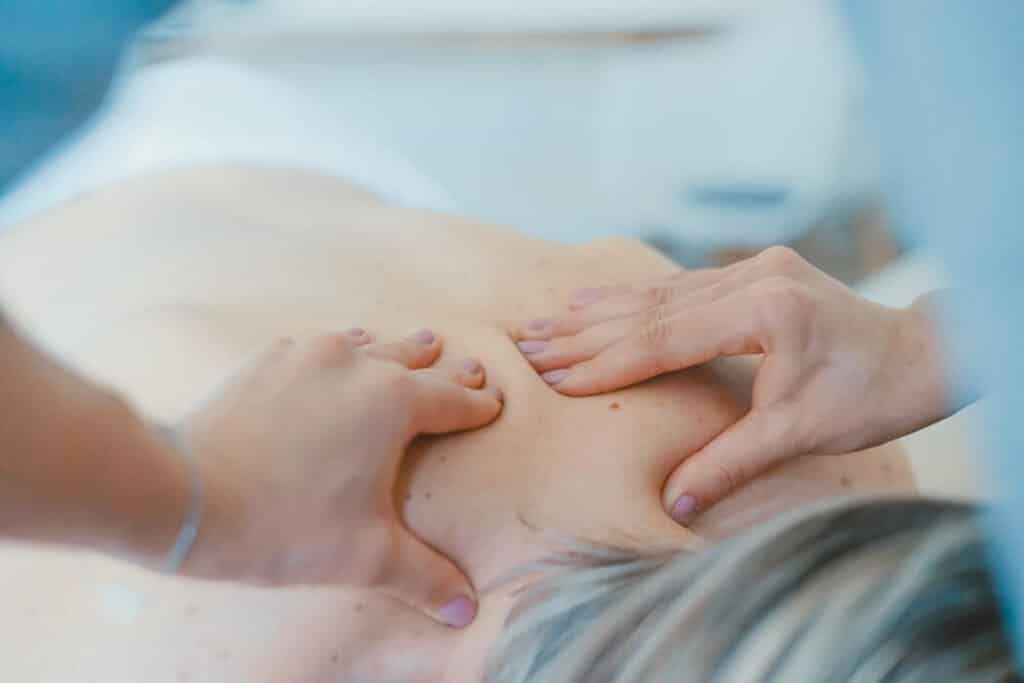
Padel back injuries
Back injuries also occur in padel as they do in other sports. The most common back injuries in padel are Lumbago (low back pain) and herniated discs. Sciatica (damage to the disc and/or nerve in the back), false sciatica (no damage to the disc or nerve), and lumbago are also back injuries that can occur in the sport.
Although back injuries can occur in any part of the back, by far the most common injury is to the lumbar region, the reason for this being that in padel the greatest strain on the back is also in the lumbar region.
Back injuries should never be ignored and should always be examined by a doctor. In the case of a suspected injury to the discs of the back, an MRI is always carried out and the results of this then determine how the rehabilitation should proceed.
Causes of common back injuries
Back injuries are no exception to many other common sports injuries, these too can occur acutely as well as after prolonged overuse. In sudden back injuries such as herniated discs, there is usually a rapid twisting of the torso (as in a common forehand or backhand stroke in padel) while the feet/toes are in a straight and forward position.
Lumbago can also occur acutely due to the small muscle ruptures that occur in the (usually) muscles of the lumbar spine. Lumbago often involves the muscles cramping and the back getting into a locked lateral flexed position, which can also be very painful. Lumbago can often be seen as a precursor to a herniated disc and should also be examined, treated, and rehabilitated by a doctor and physiotherapist.
However, pure muscular low back pain (Lumbago) is by far the most common back injury in padel and is something that results from overuse of the musculature.
How to prevent back injuries in padel
To prevent serious back injuries in padel, building core strength and core stability should always be of paramount importance. Mobility training of the torso, proper stretching of the back muscles, and regular massage with associated therapeutic stretching is also important.
An often overlooked detail in preventing back injuries is also forgetting the importance of having good paddle shoes with the best possible cushioning effect. Even in everyday life, back injuries can be prevented by wearing shoes with good cushioning and/or good shock-absorbing insoles.
Rehab to get you back
With back injuries, as with other types of sports injuries, it is always just as important to have a training program tailored to your personal circumstances. The focus should also be on static back exercises with as little flexion (bending) of the torse as possible (like sit-ups).
- The plank is a classic static torso exercise which, in the early stages of the injury, can be done standing on the knees (if necessary) and on the forearms as usual. The normal performance of the plank is lying on your stomach while resting on your forearms, putting your toes on the floor and tensing your torso while lifting your body, then keeping your body in a straight position (like a plank) with your eyes on the floor. Max. seconds x 5 times. 3-4 times a day.
- Back rows. Lie on the floor on your stomach and slowly lift your upper body about 20-30 cm (or as far as possible) from the floor, looking down at the floor and bending your arms outwards. Hold the upper position for a few seconds and then slowly return to the starting position. 3 x 20 times, 3-4 times daily.
- McKenzie method. Lie on your stomach as in the example above, but stand up and rest on your forearms, holding the position statically as your back is stretched backward, looking straight ahead. Hold for 2-3 seconds and then return to the starting position. Then repeat the exercise 10-12 times and also 3-4 times daily. The exercise can also be done with arms straight and palms on the ground, giving a greater extension of the torso.
5 tips to avoid injuries in padel
It’s always important to consider what you can do to reduce the risk of annoying sports injuries. In sports, recurrence injuries are also common, which can often be due to a variety of causes but where it is not so often due to a lack of rehabilitation from the previous original injury.
Injury prevention, or prehab, is always important in sport in order to give oneself the very best conditions to perform as well as one would like. Continuing to work on injury prevention even after the injury has healed is also always recommended. Whether you are in a rehab or prehab phase, you should always slowly and gradually increase the resistance and difficulty of your exercises as you get stronger.
1. Use supportive protection for certain body parts
There are lots of well-customized protectors on the market today that can both prevent injury while helping to reduce the strain on your injured area. Review which protection(s) are right for you and consider supportive protection, kinesiology tape and bandages are a good investment to both prevent recurrence of injuries and new injuries.
2. Do regular strength training at your level
Regular strength training is always important. Strong muscles around a previously injured knee, for example, reduce the risk of a recurrence or a new injury. Do strength training according to your personal abilities and goals, and at a level that suits you. For those who strength train to build a strong body and not to build big muscles, a medium weight resistance with several repetitions per set is recommended, such as 3 sets x 12-15 repetitions (times) per exercise.
3. Rest between sets
As much fun as it is to play padel more or less every day of the week, the body also needs recovery. Our body recovers during rest and where rest also helps to reduce the risk of injury while also ensuring that we can perform better.
Also, listen to what your body is telling you. If you feel pain in the outer muscle joint of your elbow or experience throbbing lower back pain, then further activity will not make the pain go away and can often make it worse. Rest when your body signals that it needs it too.
4. Warm up properly (more than you think)
Warming up should always be an important part of your sporting activity, whether it’s playing padel or any other sporting activity. Cheating on your warm-up also significantly increases the risk of recurrence and new injuries. A heart rate boosting warm-up for at least 10-15 minutes reduces the risk of sports injuries, while also ensuring that you perform better.
5. Stretch after playing
Stretching is important from a number of perspectives. Stretching reduces the risk of injury and ensures that you maintain and restore mobility in your muscles and joints. Stretching also relieves pain and speeds up recovery after sporting activities by helping to remove waste products from the muscles.
Stretching also increases blood circulation in the muscles and helps to keep your muscles healthy and strong. Thorough stretching of the body’s major muscle groups takes about 15-20 minutes and also helps to alleviate the worst of the aches and pains in the days following your padel training.



